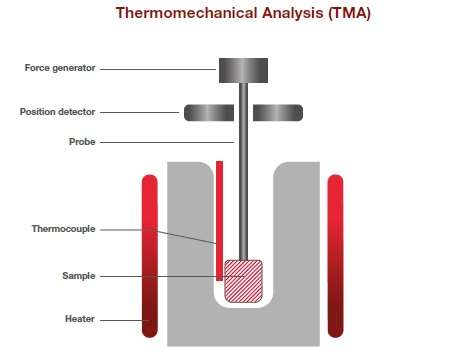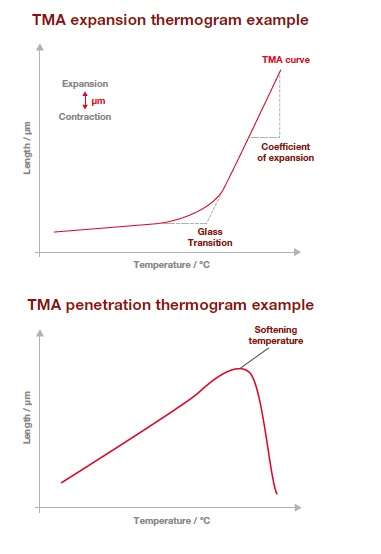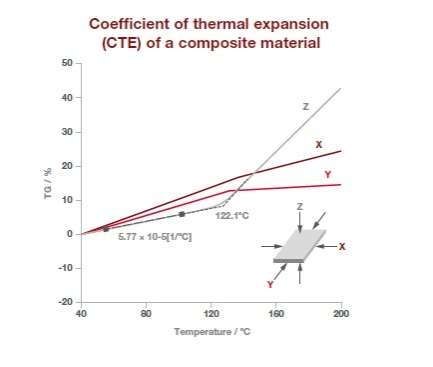Thermomechanical analysis (TMA) is a thermal analysis technique which measures dimensional changes at a micrometer scale, including deformation, in a material’s properties against time or temperature while applying a constant force (under non-oscillating stress). The stress may be compression, tension or flexure. Changes in length due to thermal expansion/shrinkage and softening are measured by the probe displacement.
A sample is placed in a TMA furnace where it’s subject to constant stress (compression, tension or flexure) while the temperature of the sample is changed in a controlled way. Any deformation of the sample at a specific temperature is detected.

A sample is placed in a TMA furnace where it’s subject to constant stress (compression, tension or flexure) while the temperature of the sample is changed in a controlled way. Any deformation of the sample at a specific temperature is detected.

The output traces above show two different types of measurement. On the top, the coefficient of expansion can be determined by the gradient of the curve above the glass transition. The bottom trace is a penetration measurement, where the softening temperature of the polymer can be determined.
You can use thermomechanical analysis to measure a material's softening, anisotropy, crystallization, creep and stress relaxation, solid-solid transitions, coefficient of thermal expansion (CTE), glass transition temperature (Tg), and compression modulus. You can also use it to determine Youngs modulus (ASTM E2769-16).
We’ve picked ASTM E831-19, standard test method for linear thermal expansion of solid materials by thermomechanical analysis as our example. This test method determines the technical coefficient of linear thermal expansion of solid materials using thermomechanical analysis techniques.
This test method is applicable to solid materials that exhibit sufficient rigidity over the test temperature range such that the sensing probe does not produce indentation of the specimen.
The TMA thermograms below shows a classic example of a linear thermal expansion measurement, which is also call coefficient of thermal expansion (CTE). For most polymers with an amorphous phase (i.e. exhibiting a glass transition), the expansion will be lower below the glass transition than after.
In this case, we can see that the slope of the linear part before the transition happening at 122.1ºC is not as steep as the one after. This is showing that the expansion is bigger at higher temperature. In this example, we can also see that CTE results will vary depending on the axis which the measurement was performed. The CTE is measured by looking at the dimension change between two different temperatures in the linear thermal expansion region and is reported as μm/(m · °C).

Using TMA, you can measure how the final part will behave. As an example, by measuring the thermal expansion of a material, you will be able to know if it will be compatible with other materials or if they will delaminate. You will also be able to find out how the material will behave under stress and if its response will change over time or temperature.
TMA is mainly used for measuring elastomers, adhesives and coatings, films and fibers, rubbers and plastics, but can also measure thermal expansion in metals and ceramics.
Our TMA instruments enable the evaluation of expansion or shrinkage of samples across a wide temperate range. Our analyzers can also perform creep, stress-relaxation,
heat shrinkage stress, stress-strain and DMA measurements. Depending on the temperature range you’re after, our TMA7100 (-170C to 600C) or TMA7300 (room temperature to 1500C) will help to ensure your material meets the quality assurance and outgoing inspection to ensure specification.
Discover moreYou might also be interested in: